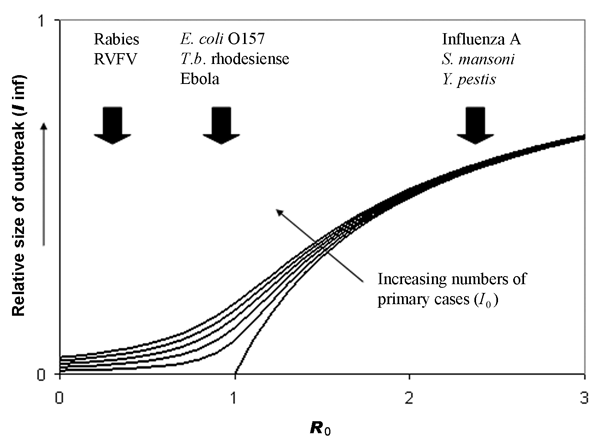Volume 11, Number 12—December 2005
Research
Host Range and Emerging and Reemerging Pathogens
Figure 3

Figure 3. . Expected relationship between outbreak size (as fraction of the population affected) and 2 key epidemiologic parameters: I0 is the number of primary cases of infection introduced into the human population from an external source such as a zoonotic reservoir (increasing in the direction indicated); R0 is the basic reproduction number, a measure of the transmissibility of the infection with the human population (see text). The curves are obtained from a modified version of the Kermack-McKendrick equation and show that expected outbreak size is particularly sensitive to small changes in I0 or R0 when R0 is close to 1. Examples of zoonotic pathogens with R0>1, R0<1 and R0 close to 1 are shown. RIVF, Rift Valley fever virus. (Reprinted with permission from [23]).
References
- Taylor LH, Latham SM, Woolhouse ME. Risk factors for human disease emergence. Philos Trans R Soc Lond B Biol Sci. 2001;356:983–9. DOIPubMedGoogle Scholar
- Woolhouse MEJ, Taylor LH, Haydon DT. Population biology of multi-host pathogens. Science. 2001;292:1109–12. DOIPubMedGoogle Scholar
- Cleaveland S, Laurenson MK, Taylor LH. Diseases of humans and their domestic mammals: pathogen characteristics, host range and the risk of emergence. Philos Trans R Soc Lond B Biol Sci. 2001;356:991–9. DOIPubMedGoogle Scholar
- Morse SS. Factors in the emergence of infectious diseases. Emerg Infect Dis. 1995;1:7–15. DOIPubMedGoogle Scholar
- Institute of Medicine. Microbial threats to health: emergence, detection, and response. Washington: National Academy Press; 2003.
- Centers for Disease Control and Prevention. Emerging infectious diseases. [cited 1 May 2005]. Available at http://www.cdc.gov/ncidod/diseases/eid/index.htm
- World Health Organization. Emerging diseases. Available at http://www.who.int/topics/emerging_diseases/en
- ProMED. The ProMED-mail archives. [cited 1 May 2005]. Available at http://www.promedmail.org
- Ecker DJ, Sampath R, Willett P, Wyatt JR, Samant V, Massire C, The Microbial Rosetta Stone database: a compilation of global and emerging infectious microorganisms and bioterrorist threat agents. BMC Microbiol. 2005;5:19. DOIPubMedGoogle Scholar
- International Committee on the Taxonomy of Viruses. Index virum. [cited 10 May 2005]. Available at http://life.anu.edu.au/viruses/Ictv/index.html
- National Center for Biotechnology Information. Taxonomy browser. [cited 10 May 2005]. Available at http://www.ncbi.nlm.nih.gov/Taxonomy/taxonomyhome.html
- CAB International Bioscience. Index fungorum. [cited 10 May 2005]. Available at http://194.131.255.4/Names/Names.asp
- Collier L, Balows A, Sussman M, eds. Topley & Wilson's Microbiology and Microbial Infection, Volume 4. London: Arnold; 1998.
- Schmidt GD, Roberts LS. Foundations of parasitology, 6th ed. London: McGraw-Hill; 2000.
- Mayo MA. A summary of taxonomic recently approved by ICTV. Arch Virol. 2002;147:1655–63. DOIPubMedGoogle Scholar
- World Health Organization. Zoonoses: second report of the joint WHO/FAO expert committee. Geneva: The Organization; 1959.
- Woolhouse ME, Dye C. Population biology of emerging and re-emerging pathogens—preface. Philos Trans R Soc Lond B Biol Sci. 2001;356:981–2. DOIGoogle Scholar
- World Organization for Animal Health. Terrestrial animal health code—2005. General definitions. [cited 1 Sep 2005]. Available at http://www.oie.int
- Hay SI, Guerra CA, Tatem AJ, Noor AM, Snow RW. The global distribution and population at risk of malaria: past, present and future. Lancet Infect Dis. 2004;4:327–36. DOIPubMedGoogle Scholar
- Corbett EL, Watt CJ, Walker N, Maher D, Williams BG, Raviglione MC, The growing burden of tuberculosis: global trends and interactions with the HIV epidemic. Arch Intern Med. 2003;163:1009–21. DOIPubMedGoogle Scholar
- Burke DS. Evolvability of emerging viruses. In: Pathology of emerging infections 2, Nelson AM, Horsburgh CR, editors. Washington: American Society for Microbiology; 1998. p. 1–12.
- Woolhouse MEJ, Haydon DT, Antia R. Emerging pathogens: the epidemiology and evolution of species jumps. Trends Ecol Evol. 2005;20:238–44. DOIPubMedGoogle Scholar
- Woolhouse MEJ. Population biology of emerging and re-emerging pathogens. Trends Microbiol. 2002;10:S3–7. DOIPubMedGoogle Scholar
- Dobson A, Foufopoulos J. Emerging infectious pathogens of wildlife. Philos Trans R Soc Lond B Biol Sci. 2001;356:1001–12. DOIPubMedGoogle Scholar